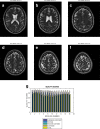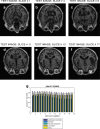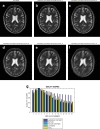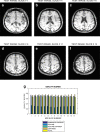Standardized quality metric system for structural brain magnetic resonance images in multi-center neuroimaging study
- PMID: 30223797
- PMCID: PMC6142697
- DOI: 10.1186/s12880-018-0266-4
Standardized quality metric system for structural brain magnetic resonance images in multi-center neuroimaging study
Abstract
Background: Multi-site neuroimaging offer several benefits and poses tough challenges in the drug development process. Although MRI protocol and clinical guidelines developed to address these challenges recommend the use of good quality images, reliable assessment of image quality is hampered by the several shortcomings of existing techniques.
Methods: Given a test image two feature images are extracted. They are grayscale and contrast feature images. Four binary images are generated by setting four different global thresholds on the feature images. Image quality is predicted by measuring the structural similarity between appropriate pairs of binary images. The lower and upper limits of the quality index are 0 and 1. Quality prediction is based on four quality attributes; luminance contrast, texture, texture contrast and lightness.
Results: Performance evaluation on test data from three multi-site clinical trials show good objective quality evaluation across MRI sequences, levels of distortion and quality attributes. Correlation with subjective evaluation by human observers is ≥ 0.6.
Conclusion: The results are promising for the evaluation of MRI protocols, specifically the standardization of quality index, designed to overcome the challenges encountered in multi-site clinical trials.
Keywords: Brain MRI; Grayscale feature image; Image moment; Image quality; Local contrast feature image; Magnetic resonance imaging (MRI).
Conflict of interest statement
Ethics approval and consent to participate
This study which focus on quality evaluation was based on the analysis of anonymized and retrospectively acquired data. Administrative permissions to access the anonymized data were separately granted by the three organizations that provided the data. ADNI gave permission to access data on April 8, 2017. NeuroRx Research Inc. gave permission to access data on January 7, 2015. BrainCare Oy. gave permission to access data on December 27, 2015. Ethics approval was deemed unnecessary according to the regulations of the Norwegian Regional Committees for Medical and Health Research Ethics (REK) published on 12 January 2012 and available at (https://helseforskning.etikkom.no/reglerogrutiner/soknadsplikt/sokerikkerek?p_dim=34999&_ikbLanguageCode=us).
Consent for publication
Not Applicable.
Competing interests
The authors declare that they have no competing interests.
Publisher’s Note
Springer Nature remains neutral with regard to jurisdictional claims in published maps and institutional affiliations.
Figures










Similar articles
-
Multi-contrast brain magnetic resonance image super-resolution using the local weight similarity.BMC Med Imaging. 2017 Jan 17;17(1):6. doi: 10.1186/s12880-016-0176-2. BMC Med Imaging. 2017. PMID: 28095792 Free PMC article.
-
Image Quality Evaluation in Clinical Research: A Case Study on Brain and Cardiac MRI Images in Multi-Center Clinical Trials.IEEE J Transl Eng Health Med. 2018 Aug 23;6:1800915. doi: 10.1109/JTEHM.2018.2855213. eCollection 2018. IEEE J Transl Eng Health Med. 2018. PMID: 30197842 Free PMC article.
-
A consistency evaluation of signal-to-noise ratio in the quality assessment of human brain magnetic resonance images.BMC Med Imaging. 2018 May 16;18(1):17. doi: 10.1186/s12880-018-0256-6. BMC Med Imaging. 2018. PMID: 29769079 Free PMC article.
-
Consensus recommendations for a standardized Brain Tumor Imaging Protocol in clinical trials.Neuro Oncol. 2015 Sep;17(9):1188-98. doi: 10.1093/neuonc/nov095. Epub 2015 Aug 5. Neuro Oncol. 2015. PMID: 26250565 Free PMC article. Review.
-
Beyond case-control study in neuroimaging for psychiatric disorders: Harmonizing and utilizing the brain images from multiple sites.Neurosci Biobehav Rev. 2025 Apr;171:106063. doi: 10.1016/j.neubiorev.2025.106063. Epub 2025 Feb 26. Neurosci Biobehav Rev. 2025. PMID: 40020797 Review.
Cited by
-
DSMRI: Domain Shift Analyzer for Multi-Center MRI Datasets.Diagnostics (Basel). 2023 Sep 14;13(18):2947. doi: 10.3390/diagnostics13182947. Diagnostics (Basel). 2023. PMID: 37761314 Free PMC article.
References
-
- Arnold D, Stone L. The clinical usefulness of routine mri assessment. Int MS J. 2010;17(2):58–63. - PubMed
-
- Zhang Y, Wang S, Phillips P, Dong Z, Ji G, Yang J. Detection of alzheimer’s disease and mild cognitive impairment based on structural volumetric mr images using 3d-dwt and wta-ksvm trained by psotvac. Biomed Signal Proc Control. 2015;21:58–73. doi: 10.1016/j.bspc.2015.05.014. - DOI
Publication types
MeSH terms
Grants and funding
LinkOut - more resources
Full Text Sources
Other Literature Sources
Medical

